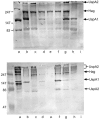Antigenic specificity of the mucosal antibody response to Moraxella catarrhalis in chronic obstructive pulmonary disease
- PMID: 16299311
- PMCID: PMC1307080
- DOI: 10.1128/IAI.73.12.8161-8166.2005
Antigenic specificity of the mucosal antibody response to Moraxella catarrhalis in chronic obstructive pulmonary disease
Abstract
Moraxella catarrhalis is an important human mucosal pathogen causing otitis media in children and lower respiratory tract infection in adults with chronic obstructive pulmonary disease (COPD). Little is known about the mucosal antibody response to M. catarrhalis in adults with COPD. In this study, 10 pairs of well-characterized sputum supernatant samples from adults with COPD who had acquired and subsequently cleared M. catarrhalis from their respiratory tracts were studied in detail in an effort to begin to elucidate potentially protective immune responses. Flow cytometry analysis was used to study the distribution of immunoglobulin isotypes in paired preacquisition and postclearance sputum samples. The results showed that immunoglobulin A (IgA) is the predominant M. catarrhalis-specific immunoglobulin isotype and that the sputum IgA contains a secretory component, indicating that it is locally produced at the mucosal site. Most patients made new sputum IgA responses to the adhesins UspA1 and Hag, along with the surface protein UspA2. A smaller proportion of patients made new sputum IgA responses to the iron-regulated proteins TbpB and CopB and to lipooligosaccharide. These results have important implications in understanding the mucosal immune response to M. catarrhalis in the setting of COPD and in elucidating the elements of a protective immune response.
Figures




References
-
- American Thoracic Society. 1995. Standards for the diagnosis and care of patients with chronic obstructive pulmonary disease. Am. J. Respir. Crit. Care Med. 152:S77-S121. - PubMed
-
- Bakri, F., A. L. Brauer, S. Sethi, and T. F. Murphy. 2002. Systemic and mucosal antibody response to Moraxella catarrhalis following exacerbations of chronic obstructive pulmonary disease. J. Infect. Dis. 185:632-640. - PubMed
-
- Barnes, P. J. 2000. Chronic obstructive pulmonary disease. N. Engl. J. Med. 343:269-280. - PubMed
Publication types
MeSH terms
Substances
Grants and funding
LinkOut - more resources
Full Text Sources
Miscellaneous

